Development of human, social and relationship, and intellectual capital
Employment in times of change
To continue to play a key role within an ever-changing environment while continuing to lead in an international market abundant in opportunities, it is necessary to become capable of enhancing know-how and meeting new challenges in the regulated and free market alike.
People are called to effectively share experiences and skills and through teamwork to reach a single objective: a decisive factor to create innovation and bring value to the business. The strong sense of belonging to the Group makes it possible to actively engage all employees in continuous improvement, which is increasingly driven by an entrepreneurial spirit, simplification and implementation capacity.
In this way, Snam continues to generate “good employment”, characterised by stable and continuous work relationships for qualified and specialised activities. Moreover, through the Snam Institute, the Company sets itself the goal of enhancing the skills not only within the company but also outside.
As at 31 December 2018, out of a total of 3,016 employees, 93% were on permanent contracts of employment. Of these, 41 had a part-time contract. The average age of Snam Group employees is 44.9, while the average length of employment is around 19.5 years.
| Download XLS (16 kB) |
(no.) |
2016 |
2017 |
2018 |
Executives |
87 |
93 |
107 |
Middle Managers |
421 |
456 |
480 |
Office workers |
1,651 |
1,655 |
1,682 |
Manual workers |
724 |
715 |
747 |
Total employees |
2,883 |
2,919 |
3,016 |
| Download XLS (16 kB) |
(no.) |
2016 |
2017 |
2018 |
Permanent contract |
2,631 |
2,755 |
2,812 |
- Of whom on part-time contracts |
45 |
42 |
41 |
Apprenticeship or internship contract |
206 |
150 |
185 |
Fixed-term contract |
1 |
14 |
19 |
| Download XLS (16 kB) |
(no.) |
2016 |
2017 |
2018 |
Hired from the market (total) |
141 |
148 |
195 |
- of which university graduates |
73 |
100 |
108 |
- of which school graduates |
66 |
48 |
86 |
- of whom other |
2 |
- |
1 |
- of which women |
35 |
53 |
42 |
Other new employees (non-consolidated companies, tender acquisitions, etc.) |
36 |
36 |
126 |
Age diversity: employees by age bracket (no.)
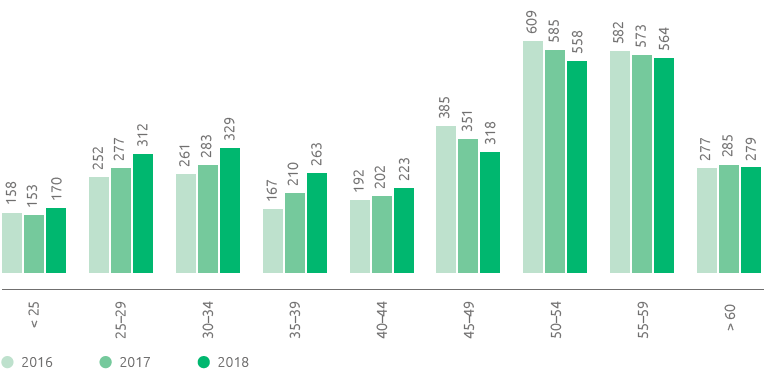
Absenteeism rate (%)
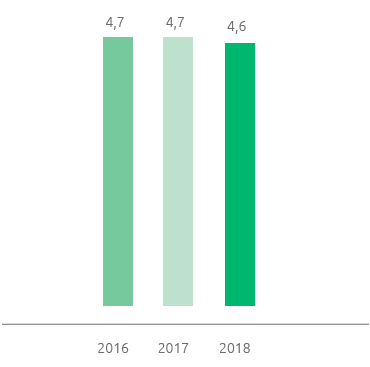
Personnel turnover (%)
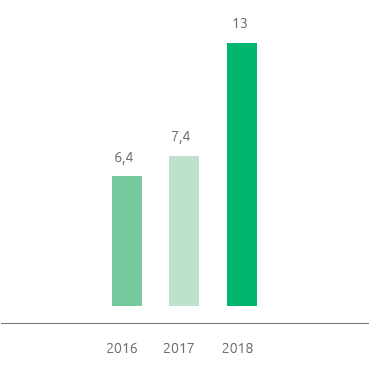
Entries and departures from market by age group (no.)
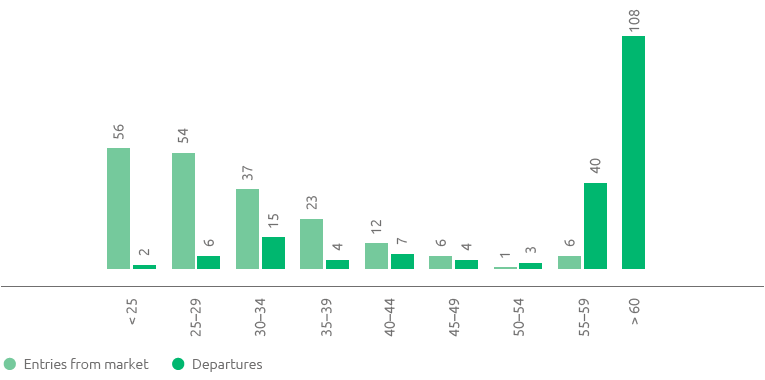
Under 35s (811) account for 27% of the company population and have increased by 98 units on 2017. The absenteeism rate does not include senior managers and it was calculated taking into consideration all hours not worked (paid and
not paid) excluding holidays and catch up leaves. In 2018, the female absenteeism rate was 4.8% and the male absenteeism rate was 4.6%.
Development of roles and skills
In 2018, the development of the roles and skills of Snam focussed on improving the leadership model, on the implementation of a model of skills, on the identification and optimisation of talent throughout the organisation, on the maintenance of solid, structured succession plans guaranteeing a sustainable line of succession and the intensification of the level of engagement. In particular, 2018 saw the launch of the new Performance Management System, a decisive part of the Talent Review Discussion and the realisation of the Succession Plans. All assessment processes are formalised and include a feedback interview, which constitutes an institutional moment for exchange and communication between the manager and the employee, also in order to gather information that can be used to define new actions for the development and enhancement of people.
All jobs within Snam, Snam Rete Gas, GNL Italia and Stogit are subject to an analytical and overall evaluation of Complexity, Responsibility, Experience and Autonomy (C.R.E.A.) factors. In 2018, 198 CREA assessments were approved.
Compensation systems are updated periodically based on a benchmark to the reference markets and taking into account the instructions received from the external stakeholders. In particular, these systems are meant to ensure recognition of the results achieved, the quality of the professional contribution provided and individual development potential of the person. In 2018, the scope of possible Long-Term Incentive Plan (ILT) beneficiaries was expanded to include all managers, with the aim of creating greater alignment of long-term variable remuneration with the primary goal of creating value for shareholders.
Executives |
Along with any annual adjustment to fixed remuneration for merit or progression of roles/responsibilities, Snam provides a variable incentive system designed to enhance the value of the professional contribution in the short term (IMA), through the allocation of an annual monetary incentive, and the medium-long-term, if necessary through the allocation of a long-term stock incentive (ILT). |
Non-executive population |
Snam adopts a short-term variable incentive plan intended to reward best performance and the young resources with potential for development. |
Professional enhancement
The People Strategy developed by Snam focuses on three main pillars: enhancing the value of human resources, increasing productivity and the level of engagement, disseminating a culture of innovation and renewal.
In this context, training plays a fundamental role in supporting management and the whole corporate population in paths to develop managerial capacity, technical skills, know how and innovation.
Snam’s commitment for 2018 was to increase the average number of training hours up to at least 32 per employee and to involve the 80% of the corporate population in at least one training session. The objective was achieved during the year with an average of approximately 36 hours of training per employee, whilst the involvement of the company population was 93%.
Extensive effort went into the worker training programmes, on sensitive matters such as health, safety and the environment. Numerous refresher, information and awareness-raising meetings were organised for all professional figures in relation to the implementation of safety measures.
To favour accurate information and the application of the principles set forth in the Model 231, the Code of Ethics and Anti-corruption legislation, specific training activities were carried out for specific segments of the corporate population. As regards training on business ethics and anti-corruption, a total of 321 hours of training were provided to 112 participants in 2018.
| Download XLS (16 kB) |
(no. hours) |
2016 |
2017 |
2018 |
Executives |
2,940 |
1,908 |
4,392 |
Middle Managers |
10,021 |
8,600 |
19,072 |
Office workers |
31,072 |
39,316 |
49,650 |
Manual workers |
38,151 |
35,522 |
34,657 |
Total |
82,184 |
85,346 |
107,771 |
| Download XLS (16 kB) |
Description |
Hours provided |
Participants |
Technical training |
58,120 |
4,454 |
Health, safety, environment and quality |
28,345 |
4,953 |
Managerial training |
19,257 |
3,822 |
Corporate welfare and work-life balance
Corporate welfare is a powerful tool that is integrated with the public welfare system and which attempts to protect people from new social risks. Corporate welfare refers to a multiplicity of interventions, both monetary and in the form of services, which on the one hand generate benefits for employees who see increasing social protection and purchasing power, on the other they become a lever fundamental for companies, which benefit from a better working and productive climate.
With the aim of fostering a positive working environment, over the years, Snam has created a welfare system based on a long tradition of attention to people, that can grow and modify over time and meet with the emerging needs and demands of the various categories of employees. The in-depth analysis of the company population, different needs and sensitivities, periodically updated, allows Snam to develop a shared, functional and effective welfare system.
Digital culture and personal well-being are the drivers of the new 2018 Welfare Plan, reorganised into five areas of intervention: Family, Education, Life-work balance, Well-being and free time, Health. The five areas are then further divided up into 28 services (company and contractual), which allow Snam to meet the most current needs of the society in which we live. Some of the most innovative activities include the dediCARE service (Family area), created to help Snam employees solve minor and major family issues like assistance to the elderly, help with schooling and babysitting. In a time that is dominated by digital communication, the Education area prepares children, teenagers and adults to a correct use of the web and social media, with coding generation courses and digital education. Within the projects of the Well-being and free time area, the workshops have been planned dedicated to food education, financial education and mindfulness, i.e. self-awareness and of the context in which we live. Alongside the services for health, home-work mobility and the concession of micro loans, the agreements have been renewed with the trade unions, with the “Welfare Premium” and Smart Working projects, designed to better meet the needs to conciliate life and work, striking an appropriate balance. Thanks to the “Welfare Premium”, the choice can be made voluntarily as to whether or not to convert a percentage of the Participation Premium into Welfare Credits that can be used to purchase services for themselves or their families. All the news and active projects are available for consultation on the website snammy.it, which has been reorganised and given a new look to be even more user-friendly for ease of browsing.
Diversity
Snam respects the dignity of everyone, and offers equal opportunities in every step and aspect of the employment relationship, avoiding all forms of discrimination based on sex, age, health, nationality, political opinion or religious views.
For Snam, diversity is a value and, in particular, gender diversity and equal opportunities: this is proven by the fact that the female component in 2018 grew compared with the previous year (+6.6%) notwithstanding a large portion of the business activities, in particular the operational ones, requires a technical training which on the market is owned by candidates which are mostly male.
The company’s female population, at the end of the year, numbered 419 resources, 13.9% of the total number of employees (13.5% in 2017). 37 women have part-time contracts, out of the 41 working in the company.
In order to make the most of diversity, in 2018 Snam continued to collaborate with Valore D, which Snam has supported since 2017, the first association of companies promoting diversity, talent and female leadership for the growth of companies and the country. This collaboration provided the employees with the chance to attend classes to enhance gender diversity, the differences that characterise different generations and cultures, for the development of an inclusive culture, a factor of innovation, competitiveness and growth for people and businesses.
125 people with disabilities work at Snam and their career path promotes inclusion and integration in company processes.
| Download XLS (16 kB) |
|
2016 |
2017 |
2018 |
Average hours of training provided to men (hours/year) |
30.2 |
31.3 |
36.9 |
Average hours of training provided to women (hours/year) |
17.0 |
15.8 |
28.7 |
Total female presence and by qualification (%)
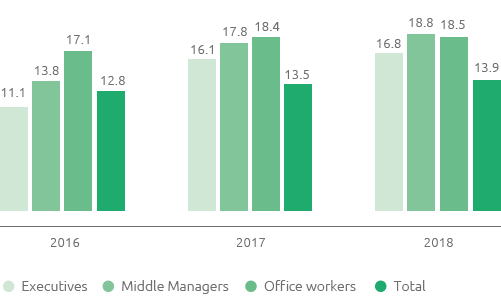
Women hired by the market (no.)
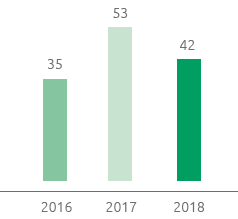
Entries from the market and exits by female

Gender and the pay gap (women/men)
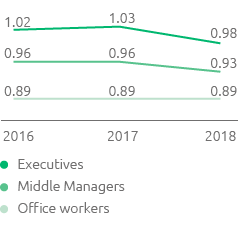
The decrease in the pay gap between men and women in 2018 is mainly due to new hiring of executives and managers in entry level, which had a greater impact on the average AGR of women.